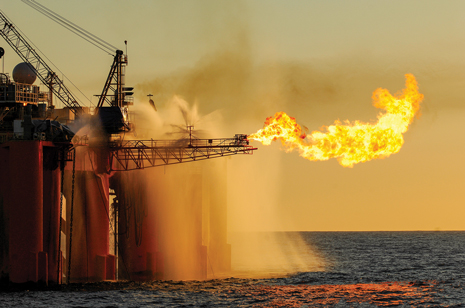 |
| Italy introduced strict offshore constraints in the wake of the 2010 Deepwater Horizon incident in the U.S. Gulf of Mexico. Image courtesy of iStock.com/Dazman. |
|
For the first time ever, Italy has mapped the full environmental performance of its oil and gas E&P sector. The Italian Petroleum and Mining Industry Association, Assomineraria, commissioned Golder Associates to analyze the sector’s effect on its surroundings, and Golder found an industry in great shape—Italian oil and gas is greener than Italy’s other industries, as well as other countries’ petroleum sectors. The findings are a great sign for Italy’s petroleum future.
To reach this promising conclusion, Golder conducted a comprehensive study that explored how the Italian petroleum sector compares to the global industry average, in terms of atmospheric emissions, water and waste management, and risk mitigation. The study marks an important step toward greater accuracy in environmental energy debates, as comparable statistics across sectors, regions and time are crucial for understanding performances in all industry areas. The results will contribute to a more enlightened discussion of Italy’s future energy strategy.
ENVIRONMENTAL AWARENESS
Italy’s hydrocarbon reserves are regarded widely as the most important in Europe, after the North Sea. They contribute to 7% of Italy’s energy demand, and reduce the country’s energy bill by approximately €6.3 billion annually. By 2020, Italy’s national energy strategy aims to double this contribution, as part of the overall attempt to revive the country’s economy. Thus, the sector is of utmost importance to the entire Italian economy.
Because of its importance, the oil and gas industry is also an object of much attention—from both its supporters and its critics. Against this backdrop, Assomineraria recognized the need for a complete assessment of its environmental performance, to support its discussions with the government about a national energy strategy. Instead of relying on entrenched opinions about resource extraction, Assomineraria wanted hard statistics, to demonstrate the petroleum industry’s real impact on both health and the environment.
To ensure the study’s findings were robust, Golder drew on decades of research from national and international organizations, such as the 2012 enviromental report from the International Association of Oil and Gas Producer. The extensive range of comparatives made the results easily communicable to all stakeholders, and helped ensure that all areas of environmental performance were covered thoroughly in the report.
ENERGY AND AIR EMISSIONS
One of the most fundamental aspects of an industry’s environmental performance is its energy consumption and, by extension, its atmospheric emissions—the greatest environmental challenge of our time. How much energy is consumed in industry production, however, depends on several variables that must all be investigated in detail.
Firstly, energy consumption is linked closely to the quality of machinery and technology. The fact that the Italian petroleum sector is so well stocked with modern technology is a major reason why its E&P sector is so energy-efficient. The technology helps counter operational conditions that otherwise are not particularly favorable in Italy—the depth of deposits is greater than in many other comparable regions, and the prominence of heavy crude oil makes extraction especially demanding. When seen in the light of these conditions, Golder found Italy’s low energy consumption to be particularly impressive, Table 1.
| Table 1. Specific energy consumption [TJ/kTOE], Italy and other regions, 2012. |
|
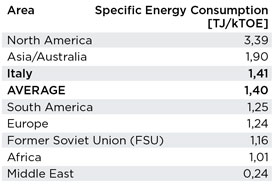
|
Another reason that atmospheric emissions are so low in Italy is that operators produce a high level of thermal energy for their own consumption. They are, therefore, able to power much of their own activities, without having to rely on third-party energy providers. Only a tiny portion of the energy that the industry needs to operate is purchased from other parties—see the relationship between A and B in Table 2—meaning operators are largely self-supplied.
| Table 2. Energy produced (A), energy purchased from third parties (B), and energy sold (C), in Italy, 2012. |
|

|
As a result of the aforementioned reasons, atmospheric emissions in Italy are much lower than other Italian industrial sectors and in line with the international average for oil and gas—Tables 3, 4 and 5 show emissions of greenhouse gases, nitrogen oxides and sulphur oxides. These correspondingly low levels of energy use and atmospheric emissions are one of the main reasons that the Italian industry is performing so well environmentally.
| Table 3. Specific CO2 emissions [ton CO2/ k toe] and specific greenhouse gas emissions [ton CO2eq/ k toe], Italy and other regions, 2012. |
|

|
| Table 4. Specific nitrogen oxide emissions, Italy and other regions, 2012. |
|
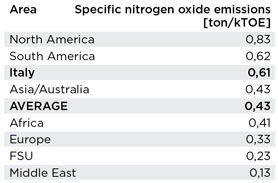
|
| Table 5. Specific sulphur oxide emissions, Italy and other regions, 2012. |
|
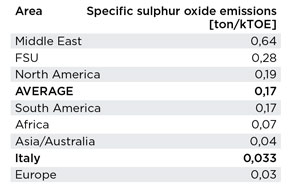
|
When operators can demonstrate low emissions from exploration and production, they stand better equipped to inform public discussions about the potential for petroleum extraction without damage to the environment. These discussions are colored invariably by debates about climate change, and are best faced head-on with hard statistics.
WATER USE
While energy consumption and atmospheric emissions tend to be the focus in climate change debates, water use is an equally significant factor, due to its scarcity in many parts of the world. The International Petroleum Industry Environmental Conservation Association (IPIECA) has been monitoring water use since 2000, and it recognizes water as an increasingly important issue for the oil and gas industry. It is, therefore, essential that operators manage water resources in a responsible manner.
Golder found that the Italian industry consumes only limited amounts of water; operators often re-inject produced water into oil fields after it has been treated, making the sector’s impact on water use minimal. Any wastewater that does occur is cleaned and disposed of as liquid waste, to authorized contractors in accordance with strict guidelines. This expertise in water management should not be underestimated as a positive contribution to the environment.
Table 6 shows how much water the industry re-injects in production—a good seven percentage points more than the world average, and as much as 31 percentage points more than the European average. This indicates an industry working hard to limit its water use. It is another point that the sector should try to communicate in debates about future energy sources. Not only in Italy, but also on a global scale, the petroleum industry should work hard to share its water management performance, to inform a public largely ignorant of its efforts.
| Table 6. Re-injected water—total, onshore and offshore, Italy and other regions, 2012. |
|
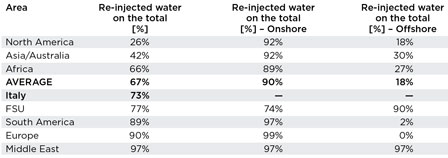
|
WASTE PRODUCTION, MANAGEMENT
Unquestionably, the production of waste is another core area for monitoring environmental performance. All industries generate waste from their activities; the oil and gas sector is no exception—scrap metals, plastics, drilling sludge and chemicals are the major types of waste here. However, the main task for operators is to limit the production of waste wherever possible, and to manage the waste that is, inevitably, produced.
In Italy, Golder found that the petroleum sector produces limited amounts of waste, and manages the waste produced with technologically advanced systems for treatment, recovery and disposal. This is especially evident when comparing the sector to other industries, such as iron and steel, or construction. The oil and gas industry creates considerably less waste than any of Italy’s other national industries. Moreover, only 10.9% of the total waste that the Italian petroleum sector produces is hazardous. Such low levels of hazardous waste indicate an industry that operates well within the boundaries of responsibility, and sets a benchmark that other industries should look to, in reaching their environmental goals.
Both water and waste management are, therefore, areas where the Italian petroleum industry excels. The fact, that two such important areas of environmental impact are well managed in Italy, is one of the most encouraging findings unearthed by Golder.
LOCAL IMPACTS
Where atmospheric emissions, water use and waste production all have the potential of substantially affecting the environment, the local impact of any industry operation will often, to a large extent, depend on its immediate surroundings. The Italian offshore industry minimizes this immediate impact by having no platforms in marine reservoirs or other protected areas.
Conversely, the onshore industry does have some production facilities in protected areas, but the impact that they have on their local areas is not excessive. This is due to regulatory frameworks and operational protocols that ensure low noise levels, low emissions, limited soil use and limited visual impact.
Golder found that soil use, in general, is limited in the Italian oil and gas sector. The relationship between the areas that operators actually use for production, and the areas that the authorities have given concessions for operators to explore, is 1 to 10,000. For offshore installations, the ratio is as large as 1 to 100,000. This selective approach is ideal for ensuring that activities only take place where the environment is safeguarded sufficiently.
RISK MANAGEMENT
Finally, in addition to observable impacts, environmental risks are also an essential part of any complete environmental assessment and something that Golder focuses on particularly. Risks can, by their very nature, never be removed completely, but they can be mitigated and controlled. To this end, the Italian petroleum industry spends between €40 million and €50 million annually on improving prevention and management systems. These investments come on top of the investments in environmental protection that follow from the development of new projects.
In areas in and around protected regions, operators also submit Environmental Impact Assessments (EIAs) that are subject to approval by authorities. Any potential impacts are then monitored closely in cooperation with universities and authorities. This monitoring is even aimed at research and education, particularly in Val d’Agri and Tempa Rossa fields in the Basilicata region, and at the Vega oil field platfrom in the Sicilian Channel. These thorough efforts are reflected clearly in the low levels of spills and accidents in Italy, Table 7. Such accidents are, perhaps, what is most damaging to the industry’s reputation. Given that the Italian industry limits oil spills to a minimum, this can only do them credit.
| Table 7. Occurrence of oil spills—total, onshore and offshore, Italy and other regions, 2012. |
|
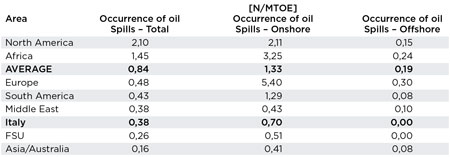
|
GREEN STATS
It is essential to have a complete understanding of the environmental impact of resource extraction, not only in Italy, but in any country with a prominent natural resource industry. Golder’s work with Assomineraria is an initiative that enlightens all industry stakeholders in Italy, and could be a valuable template for others to emulate, across a variety of regions and natural resource sectors. Benchmarking environmental performance like this is a great development for an industry that is too often associated with environmental damage.
Golder’s report demonstrates that Italy’s E&P sector has a low negative impact on the environment, and the quantified knowledge of this will be a great help for the whole industry, going forward with Italy’s economic revival. Decision-making, aided by hard statistics, is preferred by most in the industry. The recognition that this also holds true for environmental performance is an important step forward for everyone. 
|










